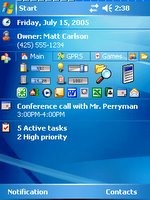Part 1 covered ebooks, launchers, and clubs. Today I’ll cover gadget news sites, games, and memory cards. Each one of these ideas are geared to giving you a new perspective and enthusiasm for that great PDA you use to organize your life.
4. Visit Gadget News Sites – If you own a Palm and you have not vi sited Palm Addicts or Treonauts, then you are missing out daily on great advice. For Windows Mobile try iPAQHQ, WindowsMobile24/7, and PDArcade. For all types of gadgets try engadget or Geek, they both cover a broad spectrum of gadgets that influence our lives with a great sense of humor.
sited Palm Addicts or Treonauts, then you are missing out daily on great advice. For Windows Mobile try iPAQHQ, WindowsMobile24/7, and PDArcade. For all types of gadgets try engadget or Geek, they both cover a broad spectrum of gadgets that influence our lives with a great sense of humor.  5. Play Games – “All Work and No Play Makes Jack a Dull Boy”. There are thousands of games appealing to all types. My games at Smart Box Design are strategy and puzzle based, with an emphasis on easy and quick to learn. Astraware, PalmGear, PocketGear, or Sniderware all have a variety of fun games. And since most games have a trial period, you have little to lose but the time to try them.
5. Play Games – “All Work and No Play Makes Jack a Dull Boy”. There are thousands of games appealing to all types. My games at Smart Box Design are strategy and puzzle based, with an emphasis on easy and quick to learn. Astraware, PalmGear, PocketGear, or Sniderware all have a variety of fun games. And since most games have a trial period, you have little to lose but the time to try them.
6. Buy a Memory Card – A 256 MB SD card at Amazon is around $20.00. Imagine how much you can add to your device. Dictionaries, games, references materials, spreadsheets, pictures of your children, music. Skip going to the movies one week and buy a memory card! Once you have it you will wonder why you didn’t get one earlier.
There’s a lot to try in this list, and any one of these items will enhance your experience and justify the costs of your Palm, Treo, or Windows Mobile Device. Try each one and see where it takes you. If you have additional ideas, post your ideas or send me an email. I look forward hearing from you.



